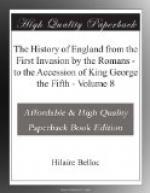[Sidenote a: A.D. 1658. Oct. 14.]
in Ireland and Scotland. In Ireland, his brother Henry governed without an opponent; in Scotland, Monk, by his judicious separation of the troops, and his vigilance in the enforcement of discipline, had deprived the discontented of the means of holding meetings and of corresponding with each other. In England he was assured of the services of eight colonels, and therefore, as it was erroneously supposed, of their respective regiments, forming one half of the regular force. But his opponents were masters of the other half, constituted the majority in the council, and daily augmented their numbers by the accession of men who secretly leaned to republican principles, or sought to make an interest in that party which they considered the more likely to prevail in the approaching struggle.[1]
From the notice of these intrigues the public attention was withdrawn by the obsequies of the late protector. It was resolved that they should exceed in magnificence those of any former sovereign, and with that view they were conducted according to the ceremonial observed at the interment of Philip II. of Spain. Somerset House was selected for the first part of the exhibition. The spectators, having passed through three rooms hung with black cloth, were admitted[a] into the funereal chamber; where, surrounded with wax-lights, was seen an effigy of Cromwell clothed in royal robes, and lying on a bed of state,
[Footnote 1: For these particulars, see the letters in Thurloe, vii. 386, 406, 413, 415, 424, 426, 427, 428, 447. 450, 452, 453, 454, 463, 490, 491, 492, 493, 495, 496, 497, 498, 500, 510, 511. So great was the jealousy between the parties, that Richard and his brother Henry dared not correspond by letter. “I doubt not all the letters will be opened, which come either to or from your highness, which can be suspected to contain business” (454). For the principle now professed by the Levellers, see note (I).]




